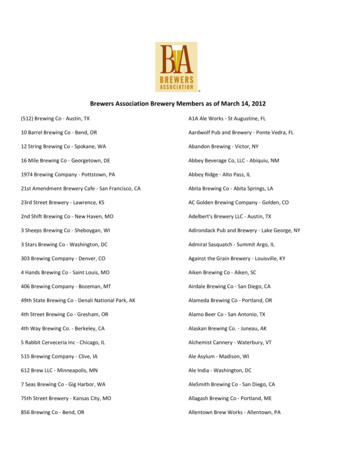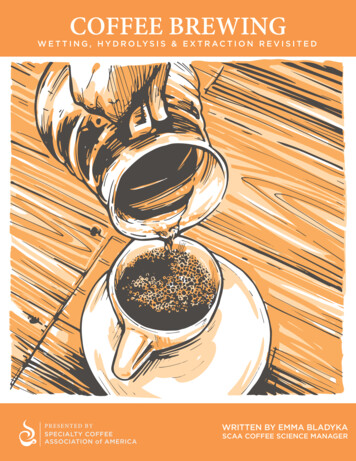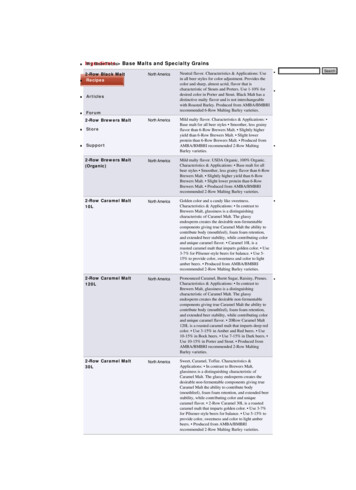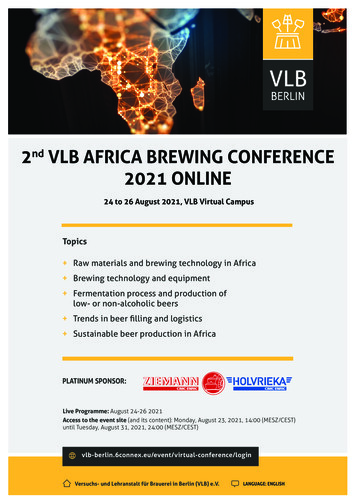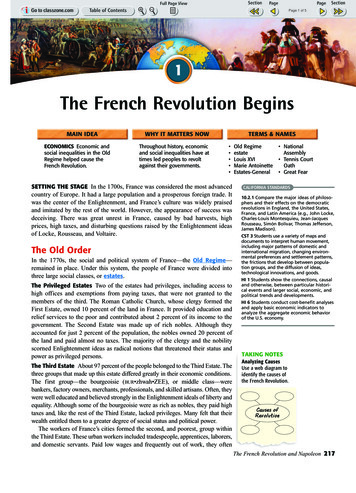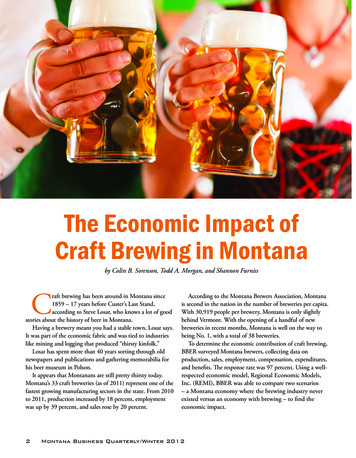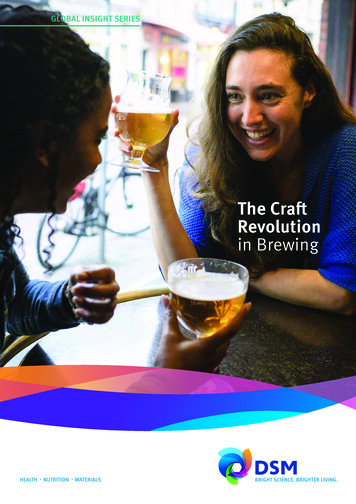
Transcription
GLOBAL INSIGHT SERIESThe CraftRevolutionin Brewing01.
GLOBAL INSIGHT SERIESTop 5 trends to watch forin craft beerDespite being steeped in tradition, the craft brewing movement isastonishingly young. But it’s growing up fast. In the United Statesthere were a mere eight craft brewers in 1980, and just 537 by 1994.Today? There are more than 6,0001 craft breweries in America alone,where consumption has grown by 500% and quadrupled its marketshare in the past decade2.02
Craft beer is here to stayNot surprisingly, we continue to see established brewers diversifyinto craft. Meanwhile, craft consumption in Europe continues tosoar with a compound annual growth rate of 11%3 estimated for thenext few years; with South and Central America projected to be thenext big craft beer region.How does all this resonate with consumers? And what does itultimately mean for the craft brewing industry? At DSM, our uniquebrewing enzyme solutions are used by much of the industry, includinga growing number of craft breweries. So we commissioned a GlobalInsights Report to uncover what craft drinkers really think. The researchcovers several thousand adult craft drinkers of all ages in sevengeographic markets (The UK, USA, Belgium, Spain, France, Italyand the Netherlands). The results speak for themselves 135More people aredrinking craft beer –and it’s the under 30swho are leadingthis revolution.This is a global revolution,with drinkers placingmore emphasis onprovenance andsustainability.And it’s a revolutionthat looks here to stay:Some 80% of craftdrinkers will continueto try new brands.Five takeaways, one big conclusion2Craft beer drinkersare putting quality,and specifically taste,above everything,including price.4Craft drinkersare increasinglyadventurousand open-minded,with only 50% expressinga specific brand loyalty.And the conclusion ?We see a new craft beer revolution brewing that’s ripe with opportunityand bursting with diversification and premiumization. As smallerbrewers enjoy significant growth, and established multinationalbrewers continue to invest in craft breweries and regional brands,we appear to be witnessing the birth of a new phenomenon: Big Craft.Read on to find out how – and why 03.
GLOBAL INSIGHT SERIESCraft beer consumers areready and willing to payfor a high-end product.
Tapping into the craft generationOur research reveals that craft beer drinking is on the increase –perhaps more than we thought.Business Director Beverages,Joana Carneiro“ We knew the market was growing, but thisshows that it’s positively booming. Perhapsthe best news for the brewing industry is thatwe appear to have an emerging new generation of craft fans – and that represents a bigopportunity for brewers around the globe.”In the past two years, just under 50% of the craft drinkers we surveyed say theynow drink more craft beer. Just 6% of this group are drinking less craft beer. Thegreatest increase took place in those aged 18-30. Crucially, this increase is eatinginto regular beer consumption with 56% of respondents saying they drink lessregular beer now.About craft beer drinkers below 30.45% drinkcraft beer66%drink craft beer forout of home at leastthe tasteoncea week64%say they drinkmorecraft beerthan 2 years agoIt’s all about the tasteWhile smart branding remains an obvious attraction for craftdrinkers (especially younger ones), a distinctive taste is the mostimportant criteria when they buy craft beer.Product ApplicationExpert Brewing, Theo Wijsman“ We knew that quality ranked highly with craftdrinkers but the significance for brewers isthat price was not such an obstacle. Craft beerconsumers are ready and willing to pay fora high-end product.”Some 75% of our respondents cited taste above all else when choosing a beer, including price. Two out of three consumers said that drinking craft beer feels more‘special’ than drinking regular beer. An equally large percentage were attracted tocraft beer based on one single word: Premium. In general, ‘tasty, and ‘quality’ arethe words that those surveyed also associate with craft beer; along with ‘local’.05.
GLOBAL INSIGHT SERIESDefining craft beerCraft drinkers value ‘locally brewed’ beer but somewhat surprisinglythis is less about where it originates from and more about how theproduct is produced.Product ApplicationExpert Brewing, Theo Wijsman“ It’s very clear that when it comes to beer, theworld is becoming a smaller place. Craft drinkersare developing increasingly exotic tastes –which is very good news for small brewerieslooking to expand, but also for larger brewerslooking to establish global premium brands.”The phrase ‘locally brewed’ will trigger the majority of our drinkers to buy a particularbeer, but this seems to be more about intimacy than proximity. Some 87% of thosesurveyed said that for them, craft was defined primarily as a beer made in smallbatches and sold through a microbrewery.The second-most relevant definition for 75% of those surveyed was a beer producedwith fresh, local ingredients and available in a range of different product types.However, the majority of our craft drinkers expressed an interest in trying local beersfrom around the world. And one third of these expressed a strong interest in tryingnew foreign craft beers.For further evidence look no further than Chicago’s Goose Island– which now haspubs from Shanghai, to Sao Paul to South Korea4.How consumers define craft beerBeer made in small batches andsold through a microbreweryFresh, local ingredientsLocal beersfrom around the world.06
The craft revolutionis all about sustainabilityCraft beer isn’t purely about the taste: it’s also about making a statement.Qualities like provenance of ingredients and sustainable productionare increasingly important to drinkers.Business Director Beverages,Joana Carneiro“ The emotional connection between craftdrinkers and their beer appears to be evenstronger than we thought. It’s a trend we’realready seeing at DSM across multiple foodsegments – and it sends a clear messageto the market: it’s essential to have productdifferentiation and careful segmentation thatreally connects with the individual.”Half our respondents believe that craft beer is more sustainable; and that a productadvertised as being sustainable was more attractive. This is borne out by the factthat ‘ethical/environmentally friendly’ was by far the number one claim by newcraft beer launches last year5. Two out of three craft drinkers we surveyed believethat craft ingredients are of a higher quality than those of regular beer. A similarnumber like to have some background information on the beer, like its ingredientsor history.07.
GLOBAL INSIGHT SERIESSeparating the hopfrom the hypeThere’s no doubt that it’s hip to love hops right now, but it’s veryclear that craft beer is here to stay.Business Director Beverages,Joana Carneiro“ This is a really interesting one. Craft drinkersseem to be committed to the beer longterm rather than the brand. It’s a bittersweetmessage for the industry in some respects, butit represents a golden, untapped opportunityfor brewers that can get it right.”Only one in five consumers we surveyed believe that the popularity of craft beerwon’t last. In fact, some 80% said they’d continue to experiment with new brands.And just 4% of those surveyed said they would not.Building brand loyalty is clearly an uphill task. Less than half our respondents saidthey were ‘quite loyal’ to a particular brand.80%believe thatthe popularity ofcraft beeris here tostaybuildingbrandloyaltyis an uphill task.08
Is the glass half-full orhalf-empty for brewers?Our research indicates that craft beer is ripe with both potential and pitfalls for the brewing industry. Perhaps the mostrelevant finding is that drinkers are not only committed to continue drinking craft beer, but also to trying new brandsfrom new breweries, and indeed new countries.For smaller brewersFor larger brewersThe growing consumer appetite for new craft experiencesrepresents a huge opportunity to grow their brands, expandinto new markets, and ultimately to grab a larger share of thislucrative premium segment.The lack of strong brand loyalty from craft drinkers coupledwith their desire to try new and exotic – but not necessarilylocal – beers represents a fantastic opportunity to reach newcustomers through an established global supply chainunderpinned by proven quality standards.As the craft market grows, so too do the expectations ofcustomers. And as the industry grows up, it will have morestakeholders to answer to – not least supermarkets andretailers with exacting standards.Our research reveals that craft beer is recognized above all forits quality. The big challenge facing small brewers? Maintainingthe quality, originality, consistency and authenticity of a productthat will need to be produced in larger quantities, travel greaterdistances and sit on shelves or in cellars for longer. The soonerthey start exploring ways to achieve this, the greater advantagethey’ll have in this new Big Craft revolution.The challenge is to continue engaging fans as a brand grows.The solution? Staying true to the values that craft lovershold dear. That means not only locally and ethically sourcedingredients, more sustainable, ‘lean brewing’ and nonwasteful production methods; and democratic brand valuesthat represent the diversion and inclusion in our societytoday.In 10 years’ time craft drinkers may be studying a label notonly to learn the ingredients, but to see how the beer wasactually made. What a competitive advantage this could befor big brewers who can make it happen and demonstratethe provenance (and credibility) of their craft beer 09.
GLOBAL INSIGHT SERIESSource informationThis DSM Insights Report conducted by Totta Research surveyed 500 people fromeach of the featured seven countries (400 for the Netherlands and Belgium).Demographics were (virtually) evenly split between five age groups: 18-30, 31-40,41-50, 51-60 & 60-plus. These groups were split (fairly) evenly between those withhigher and lower education, and heavy and light Craft drinkers. Research took theform of an online quantitative panel, conducted in December 2017.Further sources are:1 History of craft brewing. Brewers Association for Small and Independent CraftBrewers, website. Retrieved 7 June 2018.2 Craft beer market. Grand View Research, 2017.3 Craft beer market. Grand View Research, 2017.4 Brewpubs help Goose Island engage with new consumers in international markets.Beverage Daily, website. Published 29 March 2018. Retrieved 7 June 2018.5 Product claims on craft beer. Mintel. Retrieved 15 March 2018.10
011.
DSM Food Specialties - Enabling Better Food for EveryoneAt DSM Food Specialties, Enabling Better Food for Everyone is our purpose. We provide ingredients and solutions that enable our customersto make healthier and more sustainable consumer food and beverage products. We are driven to partner with our customers to create foodchoices that people around the world can truly enjoy.info.food@dsm.com www.dsm.com/foodAlthough diligent care has been used to ensure that the information provided herein is accurate, nothing contained herein can be construed to imply any representation or warranty for whichwe assume legal responsibility, including without limitation any warranties as to the accuracy, currency or completeness of this information or of non-infringement of third party intellectualproperty rights. The content of this document is subject to change without further notice. Please contact us for the latest version of this document or for further information. Since the user’sproduct formulations, specific use applications and conditions of use are beyond our control, we make no warranty or representation regarding the results which may be obtained by theuser. It shall be the responsibility of the user to determine the suitability of our products for the user’s specific purposes and the legal status for the user’s intended use of our products. DSM Food Specialties B.V. 2018 A. Fleminglaan 1 2613 AX Delft The Netherlands Trade Register Number 27235314
Five takeaways, one big conclusion Craft beer is here to stay More people are drinking craft beer- and it's the under 30s who are leading this revolution. This is a global revolution, with drinkers placing more emphasis on provenance and sustainability. Craft beer drinkers are putting quality, and specifically taste, above everything,


